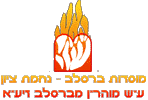|
Expansions of the Holy
Names of G–d. In standard gematria (Hebrew numerology), the numerical equivalent of Hebrew words is calculated by adding up the values of the individual letters that are their component parts (alef = 1, beis = 2, etc.). In addition, there is a “filled out” form of gematria in which the letters of a word are themselves written out fully phonetically. For example, the letter yud is equal to ten, but when written out fully, it is yud-vav-dalet and it equals twenty. The letter heh can be filled out three different ways: heh heh (HH), heh alef (HA), and heh yud (HY). Likewise, the letter vav can be written as vav vav (VV), vav alef vav (VAV), and vav yud vav (VYV). For the expansion of the Holy Names YHVH and EHYeH, see the table below. The Divine Name ELoHIM can also be filled in with a yud, a heh, or an alef.
In general, the letter yud is associated with the attribute of Chessed--this is why, for example, the AB expansion of the Tetragrammaton is aligned with the sefirah of Chochmah, the root of the side of Chessed. The letter heh is associated with Gevurah, which is why the BN form is aligned with Malchus. The letter alef is generally associated with the balance found in Da’as / Rachamim, and so it is aligned with the sefirah of Tiferes which holds the middle position (and which also includes all of the six sefiros of Zeir Anpin). This rule of thumb holds true with regards to the expansions of the Name EHYeH as well as the Name ELoHIM. Another approach within the system of gematria involves “squaring.”
This means that the first letter of the Name is written down by itself,
after which it is added to one letter at a time. For example, the Divine
Name ShaDaI would be written shin, shin dalet, shin dalet yud. The sum
total of all the letters combined is the actual “squared” gematria.
This system is associated with the aspect of judgement, and a Name written
out in this form is called a “posterior” Name. A squaring of the
Tetragrammaton can sometimes also be written “filled out” as well.
(This makes the sum total much greater.) In addition to gematria, Divine Names can themselves take different
permutations of their base letters, with varying mystical meanings. The
Name YHV has six permutations, each of which is associated with a
different sefirah of Zeir Anpin. The initial letter of any permutation
encapsulates its essence, so the rule of thumb of the yud, heh, and alef,
applies here as well. The Tetragrammaton has twenty–four possible permutations (repeated letters are treated as separate letters). The Name ELoHIM has one hundred and twenty possible permutations. In general, the more a permutation follows the original order of the Name, the more it indicates the attribute of mercy. In contrast, the more it resembles a reversed reading of the Name, the more does it indicate the attribute of judgement (Din). The Gematrias of the Letters
|
||||||||||||||||||||||||||||||||||||||||||||||||||||||||||||||||||||||||||
